View Part 1 here
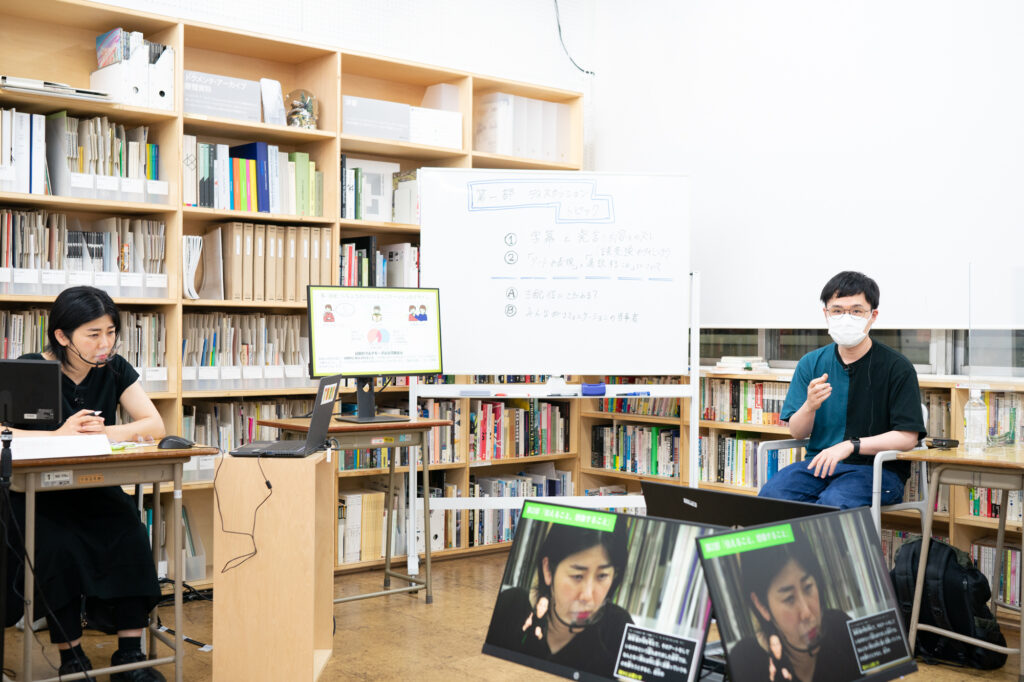
■ How do we go beyond “centrism”?
In Part 2 we held a talk entitled “Communication and Imagination.” In addition to Satsuki Ayaya, who appeared in Part 1, we were joined by guest Chiki Ogiue, a critic and radio personality who in recent years has also expanded activities of his social research support organization Chiki Lab, which looks at ways to solve social issues through social research. Also taking part in Part 2 were TURN supervisor Katsuhiko Hibino, TURN project director Tsukasa Mori, and Maria Hata from Arts Council Tokyo, continuing with her role as moderator from Part 1.
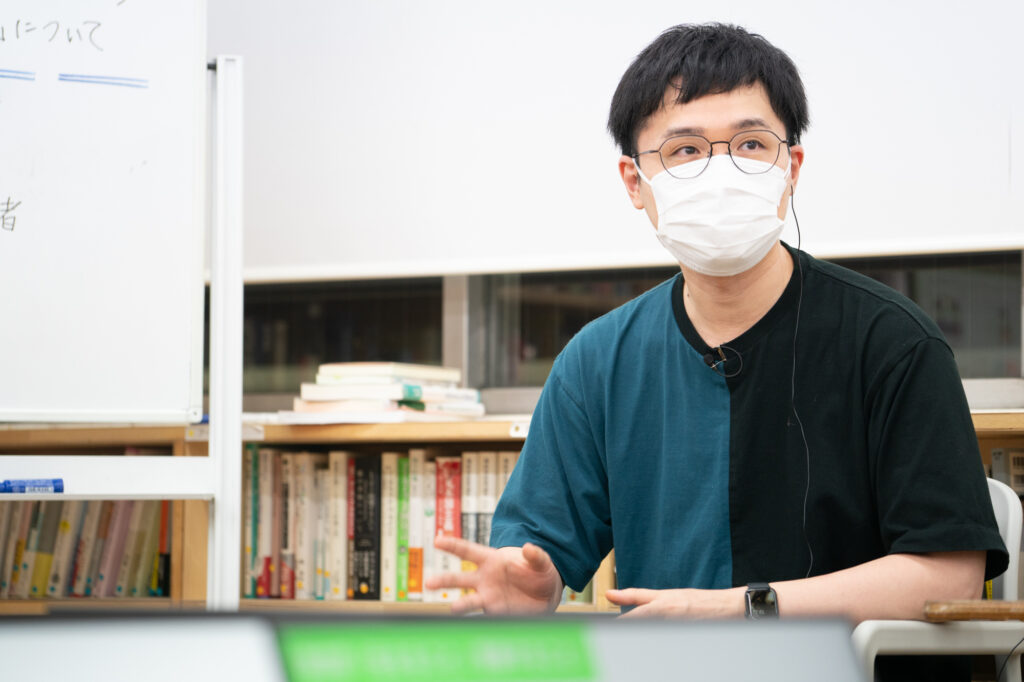
Part 2 started with Ayaya elaborating on her way of perceiving the world and forms of communication. She says that when she was young, she felt unable to adapt to life in a group environment, and felt as if she were looking at the world from the other side of a glass screen. When she was at junior high school the letters of the alphabet seemed to flicker, making it difficult for her to process information. As mentioned earlier, she began using sign language when she was at university, and although she thought about making signing her primary language, she was unable to sign like deaf people. While brooding over who she was, into her thirties she came across the field of self-support -research known as “Tojisha Kenkyu”.
Due to her “excessive intake information” and hearing “constant echoing sound like being in a bathroom,” it is difficult for Ayaya to only pick up on the sound she wants to hear, like the voice of the person she’s talking to from among different sounds. Within the so-called development disorders people have different ways of processing information; for some people it is easy to be prompted by information from the outside world and fly off into their own world; others say they can retain single words, but it’s difficult to retain what someone says in the context of a sentence.
Ayaya says the important thing is “communication design that is right for you as an individual.” In Ayaya’s case, that could mean expressing herself in writings and not forcing herself to speak, choosing an environment with no reverberation, limiting face-to-face interaction time, or taking time out for a nap. In addition, changing fonts makes it easier for her to read the alphabet, and simultaneously receiving matching information through speech and sign language makes it easier for her to process meaning. “I’m able to communicate by adjusting my environment, not by “fixing” myself or “trying my very best,” she says.
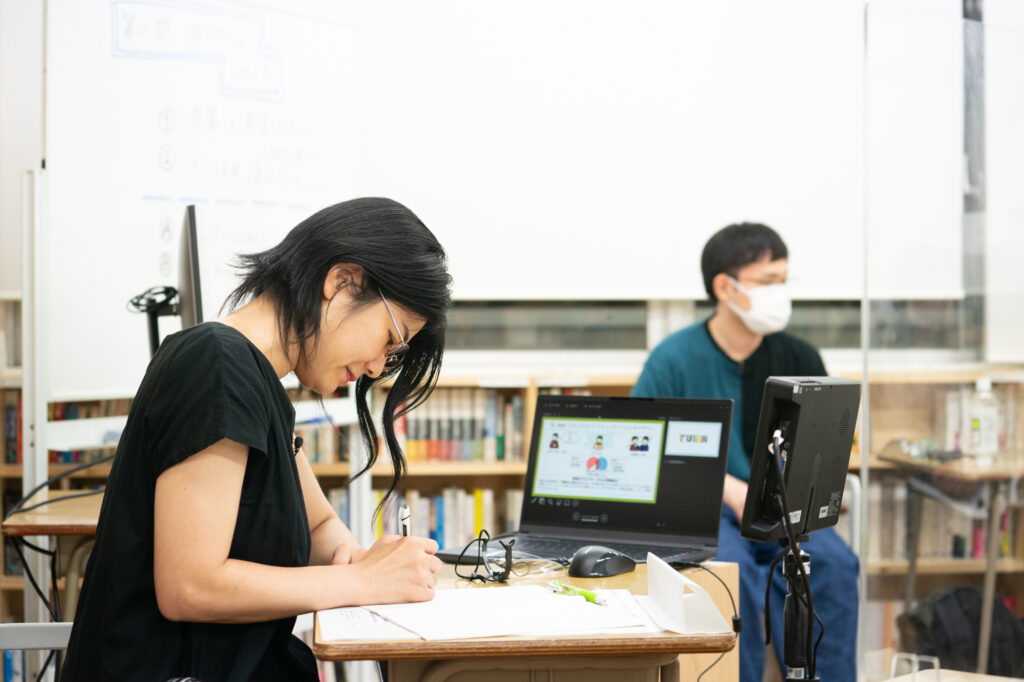
Meanwhile Ogiue brought a new perspective to the discussion from his own experience and position. Ogiue studied literature and media theory at university. At that time, he was repeatedly told by a literature teacher to “question the centrist perspective,” that is, to adopt the attitude of asking what a work concentrates on as well as what is marginalized in it. “For example, proletarian literature looks at the existence of the worker, once invisible in the literary world. And previously male-dominated literature became more focused on women following the feminist movement. This is how I was taught the importance of being aware of centrism*, determining its limits, and deconstructing its structure. ”
*Looking at situation or perspective from various political or social stances from either ends from a neutral central position.
Ogiue says that the discussion surrounding marginalized existence has slowly been spreading in recent years, not only in literature but in society at large. In fact, Ogiue’s son is on the autistic spectrum. Ogiue states “Previously, there was this idea within society that the “problem” of marginalized people lay in the body of the individual, and that they should become “healthy and normal” through rehabilitation. This is able-bodied centrism (also known as ableism). However, ideas from disability studies have spread, and the importance of improvement from an environmental perspective has now been identified more.”
“In the same way, the arena of streaming and content production, which was the theme in Part 1, has also probably been based on an able-bodied-centric premise up until now,” Ogiue says. “If you feel that streaming is impeded or held up if people with disabilities participate, it means that the accepted form of communication up until now was based on the exclusion of someone. In order to change that, you have to examine both what has and hasn’t been successfully communicated and to whom, and then have many discussions as to what sort of communication space to create,” said Ogiue.
Having listened to the discussion up to this point, Hibino commented, “I think artists have a habit of avoiding the majority when they feel they have to start ‘accommodate’ for it. To apply it to the theme of Part 2, according to my experience I’m unable to imagine people’s faces when I’m trying to communicate something to a large number of people, and I can express something better when I try to communicate something to a specific person. Maybe everyone does some kind of “Tojisha Kenkyu” on themselves and their desire to “fill the gaps” on a personal level arising in that process would trigger the beginning of communicating and imagining.”
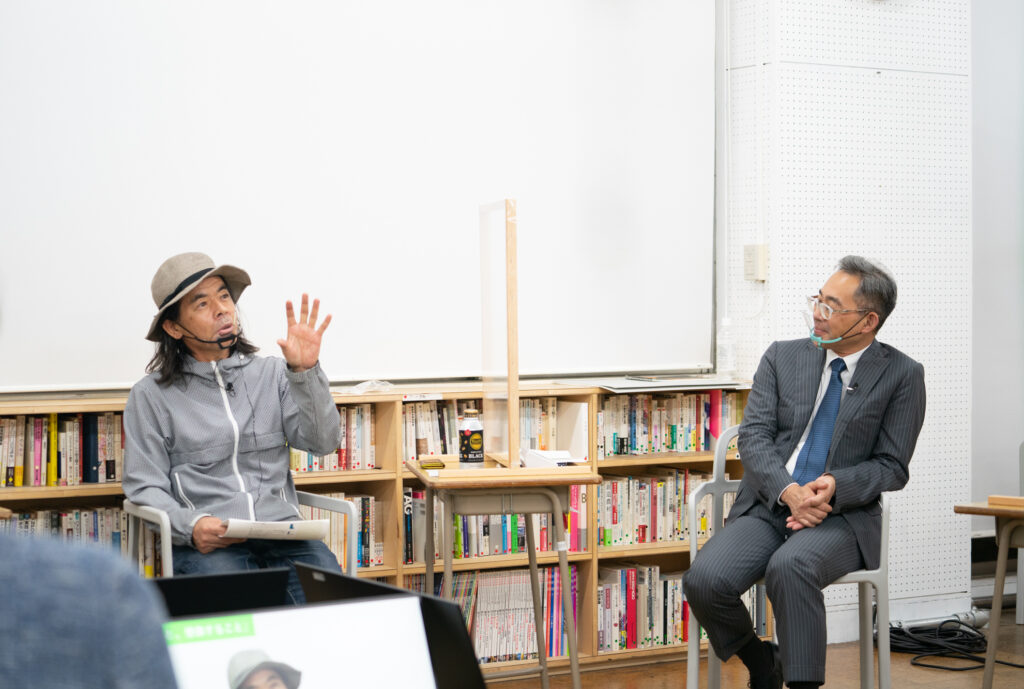
In response to Ogiue, Mori referred to today as “a period in time when previously unchallenged assumptions are beginning to change at a tremendous speed.” And Mori summarized the current situation of TURN when he said that TURN was a project that has emerged from those changes; and while it was making various innovations and efforts like livestreaming, there were still many challenges in terms of creating and approaching environments for streaming, exhibitions, and so on.
Some viewer comments during the streaming also urged understanding that a minority-friendly society didn’t threaten the majority but would make it much easier to live in.
■ What is wrong with thinking “we’re all wonderful because we’re all different”?
Based on Ayaya’s self-introduction, Mori pointed out that there tended to be a gap between the real difficulties faced by “tojisha.” and the perception of those difficulties by people seeing them from the outside. He also questioned what attitude was specifically required on the part of society towards people dealing with these difficulties.
Responding to that point, Ayaya sees the response of the majority when minorities speak up as a tendency to show understanding but to distance itself in a “please do what you want but don’t get involved with us” kind of way, and thinks some people recognize diversity in the form of the isolation of minorities. “This is a problem for us,” she says. “Rather than that, I want the majority to imagine and know what is happening within someone as a minority, even the nature of our distress and suffering. Only then will those in the majority realize our closeness to themselves, and our commonalities as people, and not think of us as distant, strange people. This is what I would like to happen.”
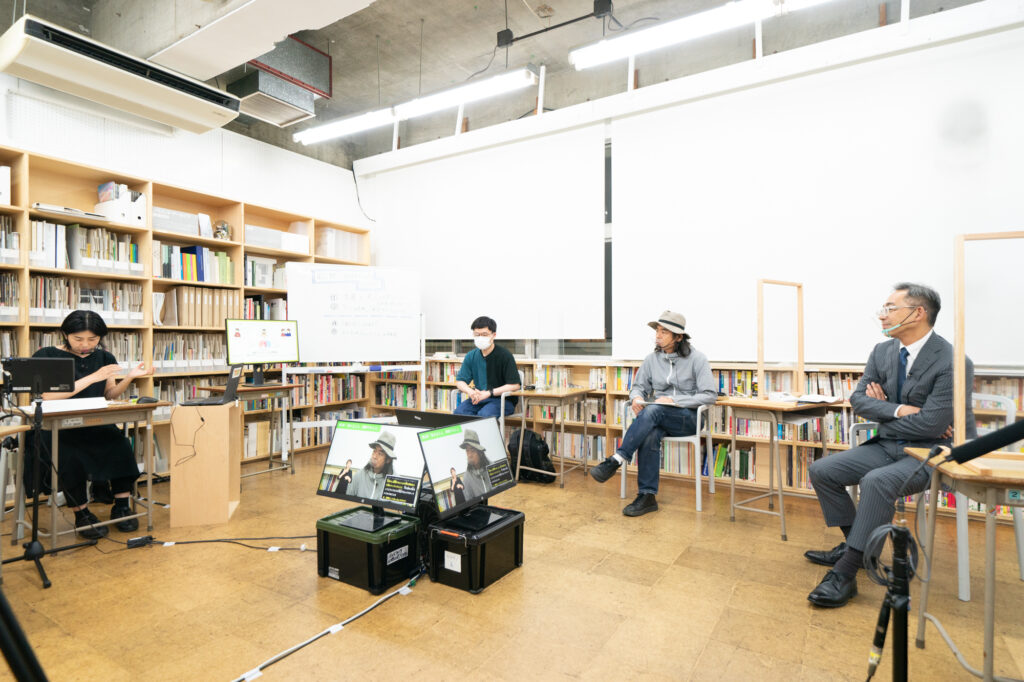
However, Ogiue said there was also a danger that the vague logic of “we’re all wonderful because we’re all different” could instead render all individuality and special characteristics null and void. In other words, the majority can come back and say “I am a unique individual as well so why do I have to treat you in a special way even though we are all unique individuals?”
Ayaya’s response was to point out that “whether LGBT or people with disabilities, they have a history of being minority groups. I think it’s important to recognize both the diversity of various minority groups like these, and the diversity of individuals in a balanced way.”
To this Ogiue responded: “The fact that people can say “we’re all wonderful because we’re all different” without changing anything already shows a privileged and exclusive attitude. For instance, when the condition of the roads becomes an issue, they say everyone is free to use roads as they are, and that people in wheelchairs can also make free use of the road. But they can’t because of the steps. The fact is that we have traditionally made roads that make walking easy for able-bodied people in particular, so taking the attitude that the situation is fair amounts to tolerating existing discriminations.”
Reflecting on something Hibino said, Ogiue pointed out: “If you convey something to the masses (the majority) without specific targets, you end up relying on its norms. When that happens, it’s easy for stereotypes and prejudice to get in, and something is going to spill over. When the majority says something “as they see it” without any consideration, in fact it may just be repeating conventional conceptions installed in society. To change that, we have to think about what kind of communication the person in front of us uses, what kind of background they have, ask the same questions of ourselves, etc., instead of looking to pervading ideas. ” He added, “Every form of expression and social movement has its own history and circumstances, and uses a chosen form of communication as a necessity. But there are some people in the world who haven’t had contact with these unique circumstances and who have not had the opportunity to learn. There is a need for criticism, artistic expression, and social movements that serve as a bridge for people like this, I think.”
Hibino had commented that during a conversation, he listens to what someone is saying in fragments, freely making associations and editing things in his head and then coming back to the conversation. In response, Hata suggested that even fragmentary or patchy understanding was one of the properties of real communication. “For instance, I think interpreters are concerned that their quality as an interpreter will be questioned if they can’t adequately interpret something problematic when they encounter it. But there’s also a natural disconnect when we are communicating on ambiguous subjects like art and expression. It might also be important to understand that communication is fundamentally something we cannot fully understand.”
■ Things that begin with slips, deviation and conflict
Near the end of Part 2, Mori posed the question, “How can we change the rhythm and way we speak our habitual language?” This provoked numerous comments about the potential inherent in communication gaps, and the best attitudes in confronting them.
In response to Hata’s previous comment, Ogiue said that communication did not only involve linguistic forms that transmit meaning but also included forms of transmission without defined meaning. For instance, a pause between words such as “um..” conveys a variety of things to the listener such as the speaker’s nervousness and difficulty in saying something, even if it has no semantic worth. But there is also the possibility of missing what the speaker really intended to convey if the speaker and listener do not share the same values.
“Until now we’ve only been tuned to a typical set of values. Traditional thought was that forms of communication not shared in by the majority did not need to be learned. But that isn’t right. What is important at times like these is a minimal awareness for tuning ourselves to individual people in individual contexts, and I think essential things lie in the trouble inherent in such communication.” He went on to say, “For instance, projecting potential conflict with social movements places a load on the majority, which encourages improvement of the social system. Mishaps in streams like today might disappear if the event were recorded, but then the potential needs wouldn’t be obvious. So that’s why I think it’s important to come up against concrete trouble and conflict” Ogiue states.
Meanwhile, taking today’s arrangements as an example, Ayaya said, “What Chiki says expresses what I was saying earlier in a much better way, and has made what Mr Hibino and Ms Hata said much easier for me to understand.” She added “Interpreters make it possible to mutually understand things that can’t be conveyed or understood within the unquestioned rules of our society. This is an exciting feeling. ” What Ayaya said reminds us of the importance of connecting and bridge-building people like interpreters.
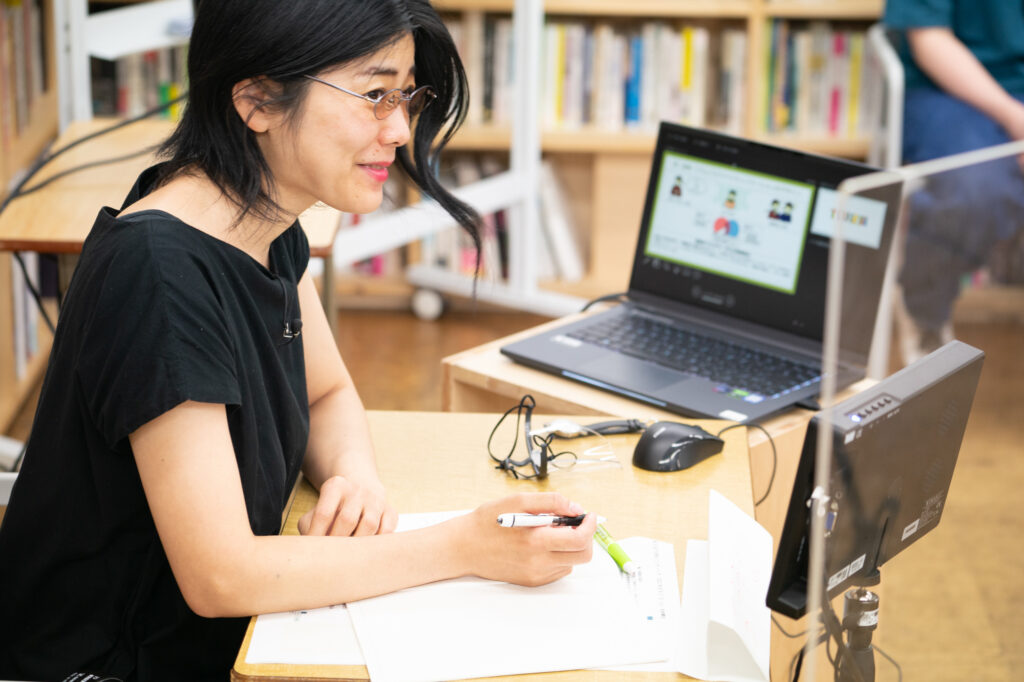
Hibino said that people are influenced by the tools they use and their environment, pointing out that a society which makes excessive demands for buses and trains to come on time will find it hard to tolerate the very concept of slips or deviation. On top of that, Hibino added that in his interaction with others he would like to have a “variable measure that expands and contracts like rubber,” something different than either perfect alignment or mismatch. Mori expanded on this. “My take on this is the importance of having a flexible spirit, and not having to do something a certain way. Sometimes you can’t see things without conflict, but at the same time you also need a margin and space where something fruitful can be brought about by such conflicts.”
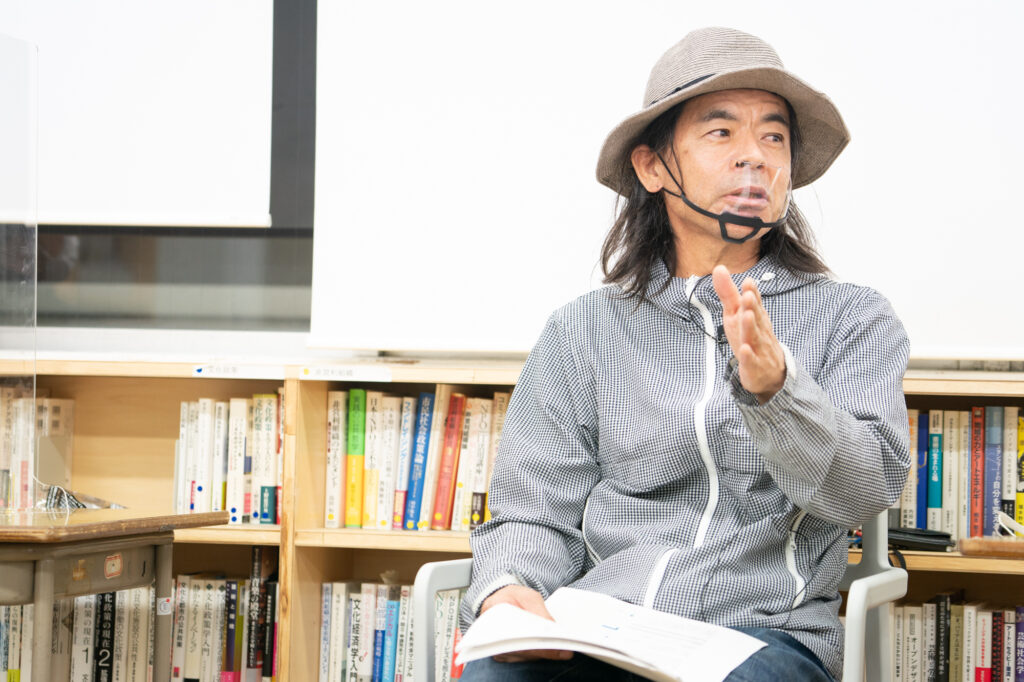
Last of all, participants shared their thoughts on the event. Hata commented: “Today’s event put importance on dealing with crossed wires rather than concentrating on a smooth delivery, and we stopped when we didn’t understand something. This clarified some things for me. We can communicate and check things with others because we are on an equal footing. Sometimes things become evident only when we are confused or take time, something you can also say about art. I want to put time and effort into this project, as I believe it will be of help for society in future.”
Ayaya made the following remark. “This has reinforced my feeling that communication disorders are things that happen between people. Today also made me feel that when there is a communication disorder in the sense of a “misunderstanding” between people, trying to reconcile those misunderstandings is in itself, communication in the real sense. Added Ogiue, “Five people had their own way of talking. I expect this made people watching the stream aware of their own ways of talking. There will always be inconsistencies in communication with others, and while this can be a source of gaining ideas, it can be a source of misery if left unchecked. In order to understand this, it’s important to have dialogue with people who have a variety of speech methods and backgrounds.”
At the end of the event, Mori read out a comment from a viewer.
“My autistic child’s relationship with a close friend began nine years ago when my child suddenly bit the other child’s hand. Even though they were only first-graders in elementary school, in the question ‘Why did you bite me?’ the now friend further wanted to know more about my child. I’m also very grateful to the adults around them for supporting the children.”
I felt that this thought-provoking comment strongly supported what the speakers at the event today had discussed.
Afterwards in the studio I asked Ayaya for her thoughts. Ayaya has trouble with off-the-cuff conversation and made notes throughout the discussion so she could remember what people had said. “It was very interesting for me that I could comfortably be involved in this meeting using my own way of communicating.” She added, “Today involved a lot of marginalized people like myself, deaf people, and maybe even Mr Hibino, being an artist. It was also interesting to feel that for some reason I had no trouble communicating in a gathering of people like this, even though I find it difficult to communicate with people on a daily basis. I didn’t feel like an “anomaly” but part of the fabric, which made me feel quietly happy.”
The next TURN Meeting will be held in December. We’ll be giving updates on this page so watch this space!
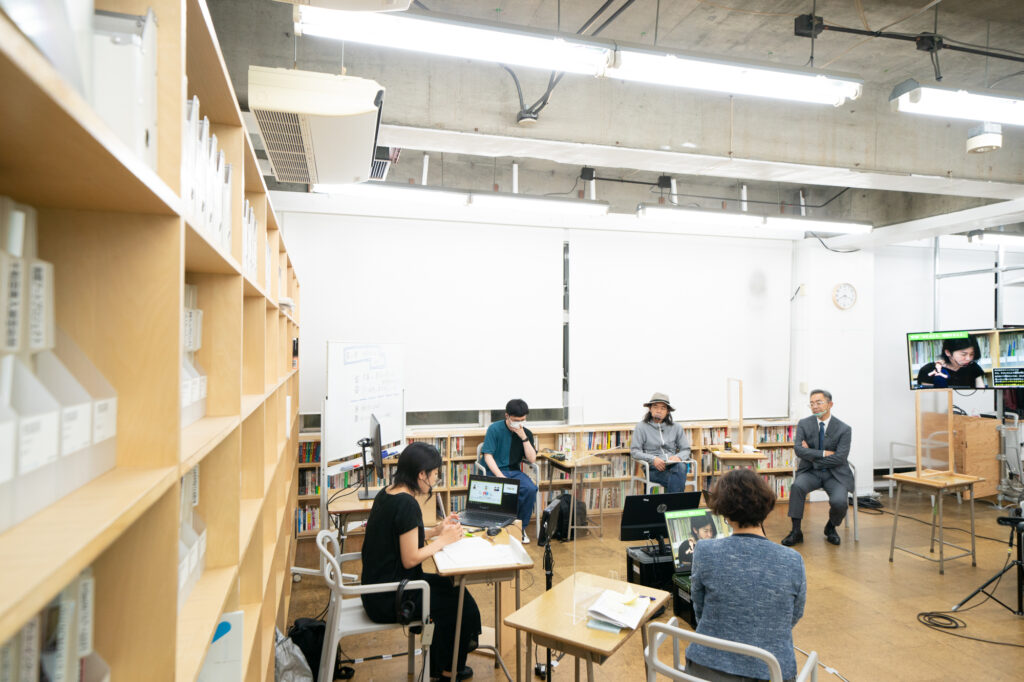
Witer: Tamaki Sugihara
Photo by: Shingo Kanagawa
Related Articles